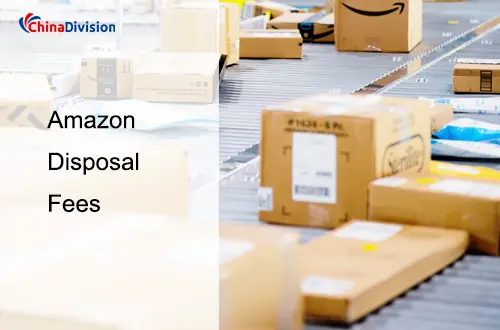How to Avoid Amazon Disposal Fees and Optimize Fulfillment?
Have you ever faced high Amazon FBA disposal fees due to excess inventory, slow-moving products, or incorrect shipments? These fees not only erode profits but can also disrupt your supply chain.
Table of Contents
- What are FBA Disposal Fees?
- User Pain Points About FBA Disposal Fees
- How are FBA Disposal Fees calculated?
- How to avoid or reduce FBA Disposal Fees?
- What is the difference between Amazon FBA disposal fees and removal fees?
- FAQs about FBA Disposal Fees
- How can Chinadivision help you optimize FBA-related costs?
This article will explain the core logic behind FBA disposal fees from the perspective of a fulfillment provider and provide practical solutions to help you optimize inventory management and reduce hidden costs.
What are FBA Disposal Fees?
FBA Disposal Fees are fees sellers incur when they entrust Amazon with the disposal of slow-moving, damaged, or destroyed inventory. When products are no longer available due to returns, incorrect shipments, seasonal excess, or compliance issues, sellers must choose one of the following options:
Removal Order: Returns inventory to a designated address or third-party warehouse (removal fees apply). Disposal: Directly entrust Amazon to destroy your inventory (disposal fees apply).

Amazon FBA disposal fees apply to the following situations:
Slow-moving or overstocked inventory
Excess inventory of seasonal products
Minorly damaged but still usable items
Items you no longer wish to store
Damaged or unsalable inventory
Products that have been returned but cannot be restocked
Items that are no longer available for sale due to policy or compliance issues
Unlike returns or removals, choosing disposal means you authorize Amazon to dispose of these items directly, rather than returning them to you or reselling them.
User Pain Points About FBA Disposal Fees
High Fees: Disposal fees are calculated per item and vary significantly based on product size, weight, and category.
Hidden Costs: Slow-moving inventory takes up storage space and may trigger long-term storage fees.
Decision Pressure: Weighing the cost and potential value of disposal versus removal is a challenge, and data support is lacking.
How are FBA Disposal Fees calculated?
Amazon's disposal fee structure is complex and primarily influenced by the following factors:
Product size: Small Standard and Oversized items have different fees.
Weight: Charges are based on the weight of the individual item, with a tiered fee increase for any excess weight.
Handling difficulty: Special categories (such as those containing batteries or liquids) may incur additional charges. The following is the standard structure of Amazon FBA disposal fees:
Standard Size Item Handling Fee:
0 to 0.5 lbs: $1.04 per item
0.5+ to 1.0 lbs: $1.53 per item
1.0+ to 2.0 lbs: $2.27 per item
Over 2 lbs: $2.89 + $1.06 per pound over 2 lbs
Oversized and Special Handling Item Handling Fee:
0 to 1.0 lbs: $3.12 per item
1.0+ to 2.0 lbs: $4.30 per item
2.0+ to 4.0 lbs: $6.36 per item
4.0+ to 10.0 lbs: $10.04 per item
Over 10.0 lbs: $14.32 + $1.06 per pound over 10 lbs USD
To calculate your total disposal cost, multiply the disposal fee per unit by the number of units you are disposing.
Note: Fees may change based on Amazon's policy adjustments, so we recommend regularly checking the latest rate schedule.
How to avoid or reduce FBA Disposal Fees?
1. Optimize inventory management
Use accurate demand forecasting tools
Implement a "small, frequent" replenishment strategy
Regularly analyze inventory turnover and promptly dispose of slow-moving items.
2. Consider alternatives
Removal Orders: Returning or transferring inventory to other channels, while still incurring fees, may be more economical.
Liquidation: Recover some value through Amazon's liquidation program.
Donation: Eligible items can be donated and receive a tax deduction.
3. Use a third-party fulfillment service.
This is precisely the professional service Chinadivision can provide to B2B businesses and e-commerce sellers. Our order fulfillment solutions include:
Smart Inventory Allocation: Automatically assigns optimal warehouses based on sales data, reducing long-distance transfers.
Multi-Channel Fulfillment: Supports inventory sharing across multiple platforms, including Amazon, independent marketplaces, and eBay.
Flexible Return Processing: Provides quality inspection, refurbishment, and repackaging services to reduce direct disposal.
Seasonal Solutions: Offers special storage and distribution programs for seasonal products.
What is the difference between Amazon FBA disposal fees and removal fees?
Removal Fees: Return the product to the seller or a designated address.
Disposal Fees: The product is destroyed or disposed of and cannot be returned.
FAQs about FBA Disposal Fees
Disposal Fees vs. Removal Fees: Which is more cost-effective?
Disposal fees are charged when Amazon processes/destroys your inventory; removal order fees are charged when inventory is returned to you from an FBA warehouse or transferred to another address. Removal order fees are generally lower and preserve the value of the inventory.
How can I estimate disposal fees in advance?
Log in to Amazon Seller Central, go to "Inventory Planning" → "Manage Excess Inventory," and use the "Create Disposal Order" function to simulate fee calculations.
How do you determine whether inventory should be disposed of or removed?
Consider the following factors:
Product residual value vs. removal/disposal costs
Possibility of resale in other channels
Storage and relisting costs
Product condition (degree of damage)
Does Amazon handle disused items in an environmentally friendly manner?
Amazon claims to prioritize environmentally friendly disposal options like donations and recycling, but the specifics of this practice are unclear. This is one reason many brands consider third-party fulfillment services.
Is there a way to completely avoid FBA disposal fees?
The most fundamental solution is precise inventory management and a multi-channel distribution strategy. Chinadivision's intelligent inventory system can help clients optimize inventory levels, fundamentally reducing the need for disposal.
How can Chinadivision help you optimize FBA-related costs?
Pre-analysis: Use sales data forecasts to help you determine optimal FBA shipment volumes.
Inventory Balancing: Maintain safety stock in our warehouses to avoid overstocking in FBA.
Multi-channel Support: Quickly redirect unsold FBA inventory to other sales channels.
Return Processing: Professional quality inspection and refurbishment services restore the value of returned items.
Cost Transparency: A clear fee structure with no hidden costs.
Although FBA disposal fees may seem small, they can significantly impact profits over time. FBA disposal fees can be a "hidden" part of your logistics costs, but with professional planning and the support of third-party fulfillment services, you can significantly reduce them while improving the resilience and sustainability of your supply chain.
Contact the Chinadivision team today to learn how our fulfillment services can help you optimize inventory management, reduce operating costs, and achieve a more sustainable e-commerce business model. Our experts will provide free consultation and customized solutions to help your business stand out from the competition.





